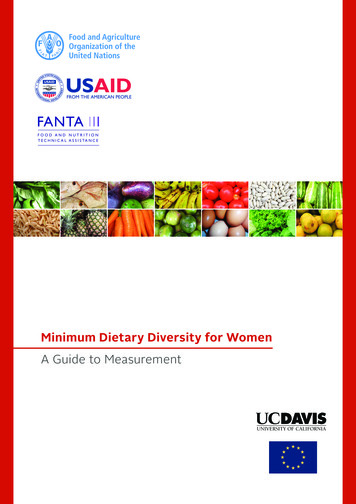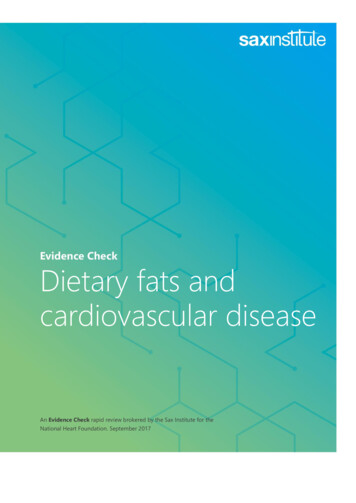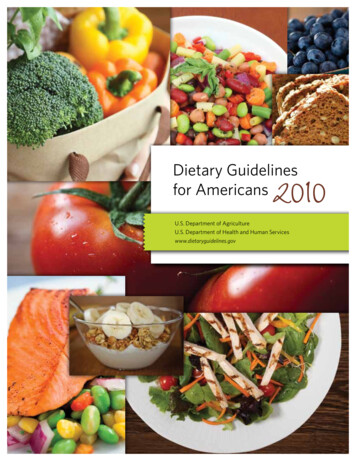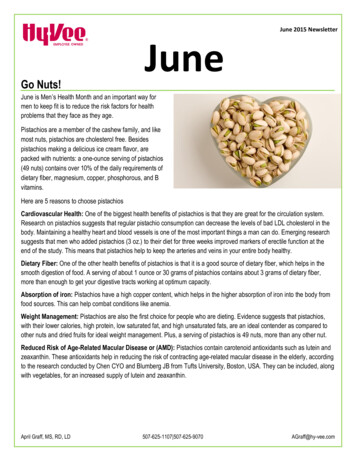
Transcription
FANTA IIIFOOD AND NUTRITIONT E C H N I C A L A S S I S TA N C EMinimum Dietary Diversity for WomenA Guide to Measurement
Minimum Dietary Diversity for WomenA Guide to MeasurementPublished bythe Food and Agriculture Organization of the United NationsandUSAID’s Food and Nutrition Technical Assistance III Project (FANTA), managed by FHI 360Rome, 2016
Recommended citation: FAO and FHI 360. 2016. Minimum Dietary Diversity for Women:A Guide for Measurement. Rome: FAO.The designations employed and the presentation of material in this information product do not imply the expressionof any opinion whatsoever on the part of the Food and Agriculture Organization of the United Nations (FAO), or ofFANTA/FHI 360 concerning the legal or development status of any country, territory, city or area or of its authorities,or concerning the delimitation of its frontiers or boundaries. The mention of specific companies or products ofmanufacturers, whether or not these have been patented, does not imply that these have been endorsed orrecommended by FAO, or FHI 360 in preference to others of a similar nature that are not mentioned.Additional funding for this publication was made possible by the generous support of the American people throughthe support of the Office of Health, Infectious Diseases, and Nutrition, Bureau for Global Health, U.S. Agency forInternational Development (USAID), under terms of Cooperative Agreement AID-OAA-A-12-00005 through the Foodand Nutrition Technical Assistance III Project (FANTA), managed by FHI 360.The views expressed in this information product are those of the author(s) and do not necessarily reflect the views orpolicies of FAO, FHI 360, UC Davis, USAID or the U.S. Government.FAO encourages the use, reproduction and dissemination of material in this information product. Except whereotherwise indicated, material may be copied, downloaded and printed for private study, research and teachingpurposes, or for use in non-commercial products or services, provided that appropriate acknowledgement of FAOas the source and copyright holder is given and that FAO’s endorsement of users’ views, products or services is notimplied in any way.All requests for translation and adaptation rights, and for resale and other commercial use rights should be made viawww.fao.org/contact-us/licence-request or addressed to copyright@fao.org.FAO information products are available on the FAO website (www.fao.org/publications) and can be purchasedthrough publications-sales@fao.org FAO, 2016ISBN 978-92-5-109153-1 (FAO)
ContentsAcknowledgements. iAbbreviations and acronyms.iiQuick Start Guide. ivSection 1.Introduction. 1Section 2.Description of food groups. 9Section 3.Model questionnaire. 23Section 4.Preparing the MDD-W questionnaire. 27Section 5.Selection and training of enumerators. 33Section 6.Tabulation, presentation and interpretation. 37References . 43Appendix 1. Sampling and design issues specific to measurement of Minimum DietaryDiversity for Women of Reproductive Age. 45Appendix 2. Guidance on assigning individual foods to food groups for Minimum DietaryDiversity for Women of Reproductive Age. 47Appendix 3. Alternative method for collecting information on food groups consumed –the list-based method. 66Appendix 4. Comparing Minimum Dietary Diversity for Women of Reproductive Ageand Infant and Young Child Feeding Minimum Dietary Diversity. 70Minimum Dietary Diversity for Women A Guide to Measurement
AcknowledgementsThis document reflects many contributions. The writing team was led by Mary Arimond1 and TerriBallard2, and included Megan Deitchler3, Gina Kennedy4 and Yves Martin-Prével5. The authors arevery grateful to participants at a July 2014 consensus meeting and a January 2015 technical meetingwho shared field experiences and provided many insights that are reflected herein. See ion/minimum-dietary-diversity-women-indicatormddw for the meeting report from July 2014 and for the lists of participants at both meetings.Previous versions of this document were reviewed by Elodie Becquey, Marie-Claude Dop, LeslieKoo, Claudia Lazarte Pardo, Warren Lee, Mary Lung’aho, Judiann McNulty, Theodora Mouratidou,Mourad Moursi and Anne Swindale; the authors are very grateful for the reviewers’ many insightfulcomments. Pauline Allemand, Kiersten Johnson and Jef Leroy also made contributions on key points.Development of this document was funded by the U.S. Agency for International Development(USAID) through the Food and Nutrition Technical Assistance III Project (FANTA), the Food andAgriculture Organization of the United Nations (FAO) and the World Food Center at the Universityof California, Davis. Finally, the authors are very grateful to members of the Women’s DietaryDiversity Project (WDDP), a long-running collaboration whose members, in addition to the fivemember writing team, include Pauline Allemand, Elodie Becquey, Alicia Carriquiry, Melissa Daniels,Marie-Claude Dop, Elaine Ferguson, Nadia Fanou-Fogny, Maria Joseph-King, Warren Lee, MouradMoursi, Marie Ruel, Liv Elin Torheim and Doris Wiesmann. WDDP members have shared thoughtsand experiences for many years and these too are reflected within. However, the writing team isresponsible for the content and any errors.Program in International and Community Nutrition, University of California, DavisFood and Agriculture Organization of the United Nations3FANTA/FHI 3604Bioversity International5Nutripass Research Unit, Institut de Recherche pour le Développement12Minimum Dietary Diversity for Women A Guide to Measurementi
Abbreviations and acronymsCAPIComputer-Assisted Personal InterviewingFAOFood and Agriculture Organization of the United NationsFBDGFood-based dietary guidelinesFCSFood Consumption ScoreHDDSHousehold Dietary Diversity ScoreIYCFInfant and young child feedingMDDMinimum Dietary DiversityMDD-WMinimum Dietary Diversity for Women of Reproductive AgeMSGMonosodium glutamateNRVNutrient Reference ValueRERetinol equivalentsRAERetinol activity equivalentsUHTUltra-high temperatureUSAIDU.S. Agency for International DevelopmentWDDSWomen’s Dietary Diversity ScoreWFPWorld Food ProgrammeWHOWorld Health OrganizationWRAWomen of reproductive ageii
iii
QUICK STARTMeasuring women’s dietary diversity – Quick Start GuideThis Quick Start Guide provides hyperlinks to guidance on specific questions and tasks and also acautionary list of common errors (see box below).All users should read the Quick Start Guide for an overview of available guidance and common pitfalls.We encourage users with no prior experience with simple food group diversity indicators to considerreading the full manual. Experienced users may find this page useful for quickly finding answers to specificquestions. Please also see the Frequently Asked Questions. Why measure Minimum Dietary Diversity for Women of Reproductive Age (MDD-W)? Indicator definition Appropriate uses of the MDD-W indicator Comparison with other food group diversity indicators (see also Appendix 4) How to collect data – introducing the guided open recall Survey sampling and design issues for food group recalls Brief descriptions of the ten MDD-W food groups Detailed food lists for the food groups “Problem foods” that are difficult to classify Model questionnaires to be adapted: open recall and list based method Translating and adapting the questionnaire Choosing and training enumerators Example of instructions for enumerators Tabulating the MDD-W indicator Recommendations for presenting MDD-W resultsCOMMON PITFALLSImproper uses of MDD-W Do not use to assess diet quality of individual women. Do not use as a basis for developing dietary guidance; use standard best practices from the WorldHealth Organization (WHO) and the Food and Agriculture Organization of the United Nations (FAO). Do not use to develop behaviour change messages; use standard best practices, for example,toolkits found from Alive & Thrive, The CHANGE Project, The C-Change Project, and K4Health.Inadequate or incorrect preparation of questionnaires If you cannot afford to adapt a model questionnaire to your context, reconsider collecting data forthis indicator. Model questionnaires for open recalls and list-based methods are available. Guidanceon adaptation is available. Do not drop or combine required food groups (rows) that are included on the model questionnaire.Incorrect comparisons with other MDD-W surveys Do not compare survey results from different seasons or agro-ecological zones without consideringseasonal and harvest patterns. See guidance in Appendix 1. In pre-post designs, do not change the questionnaire and then compare between baseline andendline.iv
v
Section 1. IntroductionBackgroundWomen of reproductive age (WRA)1 are often nutritionally vulnerable because of the physiologicaldemands of pregnancy and lactation. Requirements for most nutrients are higher for pregnant andlactating women than for adult men (National Research Council, 2006; World Health Organization[WHO]/Food and Agriculture Organization of the United Nations [FAO], 2004). Outside of pregnancyand lactation, other than for iron, requirements for WRA may be similar to or lower than thoseof adult men, but because women may be smaller and eat less (fewer calories), they require amore nutrient-dense diet (Torheim and Arimond, 2013)2. Insufficient nutrient intakes before andduring pregnancy and lactation can affect both women and their infants. Yet in many resourcepoor environments, diet quality for WRA is very poor, and there are gaps between intakes andrequirements for a range of micronutrients (Arimond et al., 2010; Lee et al. 2013).These vulnerabilities and gaps in diet quality have been recognised for a long time. However,despite decades of appeals to improve women’s diet quality and nutrition, there has been littleprogrammatic action. Historically, one major impediment has been a lack of effective platforms andprogrammes reaching adolescent girls and WRA outside of prenatal care. A lack of indicators to allowfor assessment, advocacy and accountability has been another constraint.The Minimum Dietary Diversity for WRA (MDD-W)3 indicator defined and described in this documentis a food group diversity indicator that has been shown to reflect one key dimension of diet quality:micronutrient adequacy, summarised across 11 micronutrients (Martin-Prével et al., 2015)4. Theindicator constitutes an important step towards filling the need for indicators for use in national andsubnational assessments. Such indicators must be relatively simple to collect and suitable for largesurveys5.Promotion of diverse diets is one of several approaches to improving micronutrient nutritionfor WRA; additional diet quality indicators would be needed in settings where other strategies,including fortification, biofortification and/or supplementation, are used. Furthermore, diet qualityis multidimensional. In addition to micronutrient adequacy, high-quality diets are characterised bybalance in intake of protein, carbohydrates and fat (Institute of Medicine, 2005) and moderation inconsumption of certain foods – those low in nutrient density and those associated with increasedrisks for chronic disease (George et al., 2014). In the context of rapid nutrition transitions in many12345For the purposes of this document and indicator, WRA are defined as those 15–49 years of age.“Nutrient density” refers to the ratio of nutrients (such as vitamins and minerals) to the energy content of foods.Additional background on the indicator is available at: .The 11 micronutrients were vitamin A, thiamine, riboflavin, niacin, vitamin B6, folate, vitamin B12, vitamin C,calcium, iron and zinc. See Arimond et al., 2010, and Martin-Prével et al., 2015, for the rationale for selection ofmicronutrients and for methods and results of a multistage research process assessing and comparing candidateindicators. See ion/minimum-dietary-diversity-womenindicator-mddw for a description of a 2014 consensus meeting where stakeholders reviewed results and finalisedindicator selection.Many other indicators of diet quality can be generated from more detailed dietary surveys (e.g. those employingrepeat quantitative 24-hour recalls or weighed food records), but at present detailed quantitative surveys are notfeasible and affordable for repeated implementation in most low-income countries.Minimum Dietary Diversity for Women A Guide to Measurement1
Section 1 Introductionlow- and middle-income countries, additional simple and feasible indicators are needed to reflectthese dimensions of balance and moderation.It is beyond the scope of this guide to describe or operationalise a full set of indicators for dietquality or nutrition for WRA. But consumption of food items from diverse food groups is universallyrecommended, whether or not other strategies for improving nutrition are in place6, and similarly, anindicator of food group diversity is relevant globally.Indicator definitionThe MDD-W is so named to harmonise with a similar Minimum Dietary Diversity (MDD) indicator forinfants and young children (WHO, 2008) (see p. 4 for a comparison of several food group diversityindicators currently in use).MDD-W is a dichotomous indicator of whether or not women 15–49 years of age7 have consumedat least five out of ten defined food groups the previous day or night. The proportion of women15–49 years of age who reach this minimum in a population can be used as a proxy indicator forhigher micronutrient adequacy, one important dimension of diet quality.The ten food groups are:1. Grains, white roots and tubers, and plantains6. Eggs2. Pulses (beans, peas and lentils)7. Dark green leafy vegetables3. Nuts and seeds8. Other vitamin A-rich fruits and vegetables4. Dairy9. Other vegetables5. Meat, poultry and fish10. Other fruitsThe food groups are described and defined in Section 2, and Appendix 2 provides a comprehensivelist of specific food items comprising each of the ten groups.Appropriate uses of the indicatorThe MDD-W was developed as a proxy indicator to reflect the micronutrient adequacy of women’sdiets. The main use of the MDD-W is for assessment at national and subnational levels. It is apopulation-level indicator based on a recall period of a single day and night, so although dataare collected from individual women, the indicator cannot be used to describe diet quality for anindividual woman. This is because of normal day-to-day variability in individual intakes.Groups of WRA where a higher proportion consume food items from at least five of the ten foodgroups are likely to have higher micronutrient adequacy than other groups that have a lowerproportion of women achieving the threshold of food items from at least five food groups. Putanother way, a higher prevalence of MDD-W is a proxy for better micronutrient adequacy amongWRA in the population. Groups of WRA who consume food items from five or more of the ten groupsare also highly likely to consume at least one animal-source food and either pulses or nuts/seeds andfood items from two or more of the fruit/vegetable food groups (Martin-Prével et al., 2015).67See, for example, the WHO Healthy Diet Fact Sheet n/),which summarises several WHO and FAO reports and advises that a healthy diet contains fruits, vegetables,pulses, nuts and whole grains.That is, women who have reached their 15th birthday but who have not yet reached their 50th birthday. This issometimes expressed as aged 15.0 to 49.9 years.Minimum Dietary Diversity for Women A Guide to Measurement2
Section 1 IntroductionThe MDD-W can be used: As a proxy to describe one important dimension of women’s diet quality (micronutrientadequacy) in national and subnational assessments; To compare with previous assessments, so long as survey timing accounts for seasonality8.The indicator should not be used to: Screen individuals for selection for interventions, nor to identify individuals at risk for poorintakes.In the context of programmes, this indicator may be useful when the programme design, activitiesand impact pathway indicate a potential to increase food group diversity. Note that many agriculturaland health sector projects may improve nutrition, but only some will do so by increasing food groupdiversity.In many contexts, it will also be important to increase the quantity of nutrient-dense food groupsthat are accessible and consumed by target groups. Programme users should note that consumptionof food items from five or more food groups, while useful as a population-level benchmark, does notensure micronutrient adequacy for the population, particularly if quantities of micronutrient-densefoods consumed are too small.Distinction between food group diversity indicators and food-baseddietary guidelinesIndicators and guidelines are often confused with each other. In the case of dietary diversityindicators, this may be because many countries have developed food-based dietary guidelines(FBDG) and graphics (pyramids, plates, etc.) that provide guidance to populations about consumptionof diverse diets and/or of food items from specific sets of food groups9. National FBDG are developedthrough a structured process and are meant to shape policy and national programmes (Albert, 2007).There is no global harmonisation of FBDG10, and the MDD-W threshold of at least five of ten foodgroups may not align exactly with national recommendations. The indicator should not be confusedwith a dietary guideline, nor should it be used as a basis to inform the development of guidelines orprogrammatic behaviour change communication or counselling messages.However, although the MDD-W food groups may not align perfectly with those recommendedfor consumption in national FBDG, all such guidelines do advocate consumption of diverse foodgroups. Thus, measurement of this dimension of diet quality, with an aim to assess and advocate forimprovement, is consistent with the principles behind dietary guidance given at country level. Also,in many cases, the food groups on the MDD-W questionnaire could be aggregated during analysis toreflect food groups in national FBDG and could provide information on consumption of these groupsin addition to the prevalence of meeting the MDD-W threshold.8910Seasonality is important because the relationship between food group diversity and micronutrient intakes andadequacy can vary by season. See Appendix 1 for a discussion of seasonality and of other considerations for surveydesign and sampling.FAO compiles national FBDG, which are available at ood-dietaryguidelines/en/.However, development of global guidance has been recommended in the Conference Outcome Document:Framework for Action of the Second International Conference on Nutrition Rome 19–21 November 2014.(“Recommendation 13: Develop, adopt and adapt, where appropriate, international guidelines on healthy diets”, p. 3).3
Section 1 IntroductionThe advantage of using an indicator such as MDD-W rather than a measure tailored to an individualcountry’s FBDG is the ability to compare across time and location, and even in the event thatnational FBDG change.Comparison with other food group diversity indicatorsDietary diversity has been measured in many different ways, in both research and programmaticcontexts. However, only a few simple food group diversity indicators have been promoted for widepopulation-level use in resource-poor settings. These include the Household Dietary Diversity Score(HDDS), the MDD and the Women’s Dietary Diversity Score (WDDS), which are compared with theMDD-W in Table 1.The WDDS resulted from a preliminary step in the process of developing the dichotomous MDD-W.Earlier research resulted in a suggestion of several scores that reflected micronutrient adequacy;however, no single score was proposed for global use (Arimond et al., 2010). One of these scores,a WDDS based on nine food groups, was described by FAO (2011) and selected for use by the U.S.Agency for International Development (USAID) Feed the Future and Food for Peace developmentfood assistance programmes, and others. However, demand for a dichotomous indicator grew,particularly for use in policy and advocacy contexts. Another round of research with more data setsreplicated and extended the earlier study and resulted in the proposal of the MDD-W, a dichotomousindicator based on a set of ten food groups (Martin-Prével et al., 2015).In addition to the simple food group indicators in Table 1, a variety of more complex indicators andindices have been used in specific countries or contexts. For example, the World Food Programme(WFP) uses a more complex food group diversity indicator (the Food Consumption Score [FCS]) in thecontext of food security analyses. The FCS is a weighted household-level food group score that alsoincorporates frequency of consumption over 7 days (WFP, 2008).4
Section 1 IntroductionTable 1. Simple food group diversity indicators currently in use or advocated for use atpopulation levelHDDSaIYCF MDDbWDDScMDD-WdPopulationsampled/unit ofanalysisHouseholdsInfants and youngchildren aged 6–23monthsWomen aged15–49 yearsWomen aged15–49 yearsValidatedagainstKilocalorieavailability asassessed nsity comparedwith desirabledensity forcomplementaryfoods, assessedby 24-hour recallor weighed foodrecordsMicronutrientadequacy assessedby multiple24-hour recallsMicronutrientadequacyassessed bymultiple 24-hourrecallsMeaningProxy forhouseholdlevel accessto kilocalories(dietary energy),which is onedimension ofhousehold foodsecurityProxy for theadequacy of themicronutrientdensity of infantand young childdietsProxy for theprobability ofmicronutrientadequacy ofwomen’s dietsProxy for theprobability ofmicronutrientadequacy ofwomen’s dietsReflects one ofseveral favourableinfant and youngchild feedingpracticesReflectsmicronutrientadequacy, whichis one criticaldimension of dietqualityReflectsmicronutrientadequacy, whichis one criticaldimension of dietqualityReflects economicaccess to a dietwith higherkilocalories percapitaNumber of foodgroups127910eThreshold fordichotomousindicatorNo dichotomousindicator4 or more of the 7food groupsNo dichotomousindicator5 or more of the10 food groupsIndicatortabulationincludes fats/oils, sweets, andall beverages,including alcoholYesNoNoNoFoods consumedoutside thehomeNot includedIncludedIncludedIncludedaHDDS Household Dietary Diversity Score; see ion/householddietary-diversity-score and Food and Agriculture Organization of the United Nations (FAO) (2011).bIYCF MDD Minimum Dietary Diversity indicator, as an indicator of infant and young child feeding practices; see http://www.who.int/maternal child adolescent/documents/9789241596664/en/.cWDDS Women’s Dietary Diversity Score; see FAO (2011).dMDD-W Minimum Dietary Diversity for Women of Reproductive AgeeDuring analytic work comparing candidate indicators to micronutrient adequacy for women, the 7-group IYCF MDD anddichotomous indicators based on the 9 groups in the WDDS were explored but did not perform as well as the 10-groupMDD-W (Martin-Prével et al., 2015).5
Section 1 IntroductionMethodological approaches to measurement of food group diversityWhile food group diversity indicators can be derived from detailed quantitative dietary intakesurveys, this guide is intended for users who are not in a position to conduct such surveys. Whenrelatively simple data collection approaches are required, as in a number of large-scale and multimodule surveys, food group diversity indicators can be measured using two main methods: openrecall and list-based.OPEN RECALL METHODIn a qualitative open 24-hour recall (henceforth, “open recall”), the enumerator asks a series ofstandard probing questions to help the respondent recall all foods and beverages consumed theprevious day and night and also probes for main ingredients in mixed dishes. Specifically, the recallperiod covers from when the respondent awoke the previous day, through the day and night for a24-hour period.The recall is “open” because the enumerator does not read predefined foods/groups to therespondent. Each food or beverage that the respondent mentions can be circled, underlined orticked on a predefined list. Foods not already included on the predefined list can be either classifiedby the enumerator into an existing predefined food group or recorded in a separate place on thequestionnaire and coded later into one of the predefined food groups.This method is recommended and is detailed in Section 3 (model questionnaire).LIST-BASED METHODIn the list-based method, the enumerator does read a list of foods and beverages to therespondent. The enumerator informs respondents that they should respond “yes” for each food orbeverage consumed during the specified recall period of the previous day and night. The enumeratorcontinues by reading a list of foods organized in groups, giving multiple examples for each foodgroup.There is anecdotal evidence that data collected with this method are less complete. An examplequestionnaire and more details are given in Appendix 3.COMPARISON OF METHODSThere are advantages and disadvantages to each method; these are detailed in Table 2. This guidedescribes and recommends the open recall because it may lead to more accurate and completerecall of all foods and beverages consumed.Of key concern are the linked issues of respondent burden and the time needed (and thus cost) toimplement the recall. There is no universal answer regarding which method is quicker, because itdepends on the simplicity or complexity of the woman’s diet, on the length of the food group list11and on the number of examples needed for each food group on a list-based questionnaire. Whendiets are simple, the open recall is likely to be the quicker of the two.11See Section 2 for an explanation of required and optional food and beverages categories (rows) for the MDD-Wquestionnaire.6
Section 1 IntroductionTable 2. Advantages and disadvantages of two recall methodsAdvantagesOpen recall methodList-based method Intuitive for both the enumeratorand the respondent Possibly lower capacity requirements forenumerators Structured probing Shorter training time for enumerators Enumerator (rather thanrespondent) has the task ofmatching foods consumed withfood groups and examples listedin questionnaire, leading to morecorrect classification of foods Easier to programme in Computer-AssistedPersonal Interviewing (CAPI) applicationsa May lead to more complete recallof foodsDisadvantages Longer training time required Requires enumerators to havea good understanding of theobjectives of the questionnaire andreasonable knowledge of foods asacquired, prepared and consumedin the survey area(s) More difficult to programmein Computer-Assisted PersonalInterviewing (CAPI) applicationsa Requires the respondent to correctlyidentify foods she consumed as belonging tofood groups with examples as read from thelist, which may result in misclassification offoods into food groups Requires the respondent to mentally “takeapart” mixed dishes and to remember torespond for each main ingredient Requires the respondent to mentally moveback and forth in time as foods are mentioned May be more likely to elicit biased responses,for example, if respondents aim to please theenumerator (by saying “yes”) or give untruepositive responses for high-status foods, suchas meat May be more likely to lead to omission of foodsconsumed, because there is no probing at thelevel of the eating episode May lead to different results when the numberof food groups/food examples in the list differs(e.g. from previous surveys or surveys in otherareas) Anecdotally reported to be more tedious forrespondents and enumerators, particularlywhen food group lists are longa CAPIapplications allow direct data entry (no paper forms).7
8
Section 2. Description of food groupsAs noted in Section 1, MDD-W is a dichotomous indicator of whether or not women 15–49 yearsof age have consumed at least five out of ten defined food groups the previous day or night. Thissection provides a description of each of the ten MDD-W food groups:1. Grains, white roots and tubers, and plantains6. Eggs2. Pulses (beans, peas and lentils)7. Dark green leafy vegetables3. Nuts and seeds8. Other vitamin A-rich fruits and vegetables4. Dairy9. Other vegetables5. Meat, poultry and fish10. Other fruitsThe food groups that make u
Rome, 2016. Recommended citation: FAO and FHI 360. 2016. Minimum Dietary Diversity for Women: . FANTA/FHI 360 concerning the legal or development status of any country, territory, city or area or of its authorities, or concerning the delimitation of its frontiers or bou










